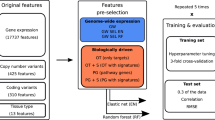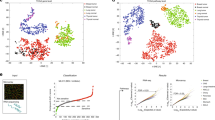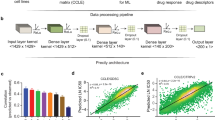Abstract
We have used the COMPARE computer algorithm and Nm23 expression as a marker of tumor metastatic potential to examine the in vitro antiproliferative activity of chemotherapeutic drugs on human breast carcinoma and melanoma cell lines. None of 171 compounds in clinical use or under development and only 40 of 30,000 repository compounds exhibited preferential growth inhibition of low-Nm23-expressing, metastatically aggressive cell lines with a Pearson correlation coefficient of ≤0.64. Characterization of one compound, NSC 645306, is presented including in vivo activity in a hollow fiber assay. The data demonstrate a novel approach to drug identification for aggressive human tumors.
This is a preview of subscription content, access via your institution
Access options
Subscribe to this journal
Receive 12 print issues and online access
$209.00 per year
only $17.42 per issue
Buy this article
- Purchase on Springer Link
- Instant access to full article PDF
Prices may be subject to local taxes which are calculated during checkout
Similar content being viewed by others
References
Monks, A. et al. Feasibility of a high flux anticancer drug screen using a diverse panel of cultured human tumor cell lines. J.Natl.Cancer Inst. 83, 757–766 (1991).
Boyd, M. & Paull, K. Some practical considerations and applications of the National Cancer Institute In vitro Anticancer Drug Discovery Screen. Drug Dev. Res. 34, 91–109 (1995).
Paull, K. et al. Display and anlysis of patterns of differential activity of drugs against human tumor cell lines: Development of mean graph and COMPARE algorithm. J. Natl. Cancer Inst. 81, 1088–1092 (1989).
Fitzsimmons, S. et al. Reductase enzyme expression across the National Cancer Institute tumor cell line panel: Correlation with sensitivity to Mitomycin C and EO9. J. Natl. Cancer Inst. 88, 259–269 (1996).
Paull, K., Lin, C., Malspeis, L. & Hamel, E. Identification of novel antimitotic agents acting at the tubulin level by computer-assisted evaluation of differential cytotoxicity data. Cancer Res. 52, 3892–3900 (1992).
Bai, R. et al. Halichondrin B and Homohalichondrin B, marine natural products binding in the vinca domain of tubulin. J. Biol. Chem. 266, 15882–15889 (1991).
Paull, K., Hamel, E. & Malspeis, L. Prediction of biochemical mechanism of action from the in vitro antitumor screen of the National Cancer Institute, in Cancer ChemotherapeuticAgents. (ed. W.O. Foye) 9–45 (ACS, Washington, DC, 1995).
Weinstein, J.N. et al. An information-intensive approach to the molecular pharmacolocy of cancer. Science (in the press).
Alvarez, M. et al. Generation of a drug resistance profile by quantitation of mdr-1/P-glycoprotein in the cell lines of the National Cancer Institute Anticancer Drug Screen. J. Clin. Invest. 95, 2205–2214 (1995).
Steeg, P.S. et al. Evidence for a novel gene associated with low tumor metastatic potential. J. Natl. Cancer Inst. 80, 200–204 (1988).
DeLaRosa, A., Williams, R.L. & Steeg, P.S. Nm23/nucleoside diphosphate kinases: Toward a structural and biochemical understanding of its biological functions. Bioessays 17, 53–62 (1995).
Leone, A. et al. Reduced tumor incidence, metastatic potential, and cytokine responsiveness of nm23-transfected melanoma cells. Cell 65, 25–35 (1991).
Leone, A., Flatow, U., VanHoutte, K. & Steeg, P.S. Transfection of human nm23-H1 into the human MDA-MB-435 breast carcinoma cell line: Effects on tumor metastatic potential, colonization, and enzymatic activity. Oncogene 8, 2325–2333 (1993).
Parhar, R.S. et al. Effects of cytokine mediated modulation of Nm23 expression on the invasion and metastatic behavior of B16F10 melanoma cells. Intl. J. Cancer 60, 204–210 (1995).
Baba, H. et al. Two isotypes of murine nm23/Nudeoside Diphosphate Kinse, nm23-M1 and nm23-M2, are involved in metastatic suppression of a murine melanoma line. Cancer Res. 55, 1977–1981 (1995).
Fukuda, M. et al. Metastatic potential of rat mammary adenocarcinoma cells associated with decreased expression of nucleoside diphosphate kinase/nm23: Reduction by transfection of NDP Kinase a isoform, an nm23-H2 gene homolog. Intl. J. Cancer
Kantor, J.D., McCormick, B., Steeg, P.S. & Zetter, B.R. Inhibition of cell motility after nm23 transfection of human and murine tumor cells. Cancer Res. 53, 1971–1973 (1993).
Howlett, A.R., Petersen, O.W., Steeg, P.S. & Bissell, M.J. A novel function for Nm23: Overexpression in human breast carcinoma cells leads to the formation of basement membrane and growth arrest. J. Natl. Cancer Inst. 86, 1838–1844 (1994).
Ferguson, A. et al. Increased sensitivity to cisplatin by nm23-transfected tumor cell lines. Cancer Res. 56, 2931–2935 (1996).
Thompson, E. et al. Association of increased basement membrane invasiveness with absence of estrogen receptor and expression of vimentin in human breast cancer cell lines. J. Cell Physiol. 150, 534–544 (1992).
Price, J.E., Polyzos, A., Zhang, R.D. & Daniels, L.M. Tumorigenicity and metastasis of human breast carcinoma Cell lines in nude mice. Cancer Res. 50, 717–721 (1990).
Iliopoulos, D. et al. Inhibition of metastases of a human melanoma xenograft by monoclonal antibody to the GD2/GD3 gangliosides. J. Natl. Cancer Inst. 81, 440–444 (1989).
Herlyn, D. et al. In vitro properties of human melanoma Cells metastatic in nude mice. Cancer Res. 50, 2296–2302 (1990).
Juhasz, I. et al. Growth and invasion of human melanomas in human skin grafted to immunodeficient mice. Am. J. Pathol. 143, 528–537 (1993).
Hollingshead, M.G. et al. In vivo cultivation of tumor Cells in hollow fibers. Life Sciences 57, 131–141 (1995).
Stracke, M.L. et al. Insulin-like growth factors stimulate chemotaxis in human melanoma Cells. Biochemical and BiophysicalResearchCommunications 153, 1076–1083 (1988).
Theodorescu, D., Caltabiano, M., Grieg, R., Rieman, D. and Kerbel, R.S. Reduction of TGF-beta activity abrogates growth promoting tumor Cell-Cell interactions in vivo. J. Cell. Physiol. 148, 380–390 (1991).
Schwartz, L.C., Gingras, M., Goldberg, G., Greenberg, A.H. & Wright, J.A. Loss of growth factor dependence and conversion for transforming growth factor B1 inhibition to stimulation in metastatic H-ras transformed murine fibroblasts. Cancer Res. 48, 6999–7003 (1988).
Hafez, M., Infante, D., Winawer, S. & Friedman, E. Transforming growth factor β1 acts as an autocrine growth reglulator in colon enterocytic differentiation but not in goblet Cell maturation. Cell Growth Diff. 1, 617–626 (1990).
Sethi, M. Inhibition of reverse transcriptase activity by benzophenanthridine alkaloids. J. Natural Products 42, 187–196 (1979).
Tan, G., Pezzuto, J. & Kinghorn, A. Evaluation of natural products as inhibitors of human immunodeficiency viruse type I (HIV-1) reverse transcriptase. J.Natural Products 54, 143–154 (1991).
Lee, J., MacFarlane, J., Zee-Cheng, R. & Cheng, C. Inhibition of catechol O-methyl-transferase and transfer RNA methyltransferase by Coralyne, nitidine and related compounds. J. Pharmaceutical Sciences 66, 986–989 (1977).
Sethi, V. Inhibition of mammalian and Oncornavirus nucleic acid polymerase activities by Alkoxybenzophenanthridine alkaloids. Cancer Res. 36, 2390–2395 (1976).
Wang, L.-K., Johnson, R. & Hecht, S. Inhibiton of topoisomerase I function by Nitidine and Fagaronine. Chem. Res. Toxicol. 6, 813–818 (1993).
Kovacic, P. et al. Charge transferoxy radical mechanism ofr anti-cancer agents. Anti-cancer Drug Design 1, 197–214 (1986).
Suffness, M. & Douros, J., Miscellaneous natrual products with antitumor activity. in Anticancer Agents Based on Natural Product Models. 465–487 (Academic Press, New York, 1980).
Rosengard, A.M. et al. Reduced Nm23/Awd protein in tumor metastasis and aberrant Drosophila development, Nature 342, 177–180 (1989).
Stermitz, F., Gillespie, J., Amoros, L., Romero, R. & Stermitz, T. Synthesis and biological activity of some antitumor benzophenanthridium salts. J. Med. Chem. 18, 708–715 (1975).
Benedetti-Doctorvich, V. et al. J. Med. Chem. 37, 711–718 (1994).
Stracke, M.L. et al. Identification, purification, and partial sequencing analysis of autotaxin, a novel motility-stimulating protein. J. Biol. Chem. 267, 2524–2529 (1992).
Author information
Authors and Affiliations
Rights and permissions
About this article
Cite this article
Freije, J., Lawrence, J., Hollingshead, M. et al. Identification of compounds with preferential inhibitory activity against low-Nm23-expressing human breast carcinoma and melanoma cell lines. Nat Med 3, 395–401 (1997). https://doi.org/10.1038/nm0497-395
Received:
Accepted:
Issue Date:
DOI: https://doi.org/10.1038/nm0497-395
This article is cited by
-
Mutations at the dimer interface and surface residues of Nm23-H1 metastasis suppressor affect its expression and function
Molecular and Cellular Biochemistry (2020)
-
Linking pathway gene expressions to the growth inhibition response from the National Cancer Institute's anticancer screen and drug mechanism of action
The Pharmacogenomics Journal (2005)
-
Comparing cDNA and oligonucleotide array data: concordance of gene expression across platforms for the NCI-60 cancer cells
Genome Biology (2003)
-
Serum levels of the nm23-H1 protein and their clinical implication in extranodal NK/T-cell lymphoma
Leukemia (2003)
-
Pharmacogenomic analysis: correlating molecular substructure classes with microarray gene expression data
The Pharmacogenomics Journal (2002)



